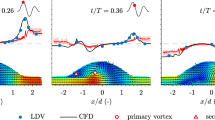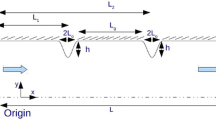Abstract
Pulsatile flow through a tube featuring a sinusoidal bulge is computed in order to determine the flow dynamics and wall shear-stress conditions encountered under conditions representative of blood flow through a human abdominal aortic aneurysm. A high-order spectral-element algorithm is employed to accurately determine velocity and vorticity fields, plus wall shear stresses, which are notoriously difficult to measure experimentally. A greater level of detail in the flow is revealed when compared to recent particle image velocimetry experiments. For both the mean and standard deviation of wall shear stress, minimum levels are found at the widest point of the aneurysm bulge, and maximum levels are recorded in the distal (downstream) region of the bulge. In an aneurysm with length and maximum diameter 2.9 and 1.9 times the artery diameter, respectively, peak instantaneous wall shear stress is 2.4 times greater than the peak wall shear stress recorded in a healthy vessel.
Similar content being viewed by others
Abbreviations
- WSS :
-
Wall shear stress
References
Lasheras JC (2007) The biomechanics of arterial aneurysms. Ann Rev Fluid Mech 39: 293–319
Astradsson A, Astrup J (2001) An intracranial aneurysm in one identical twin, but no anerusym in the other. Br J Neurosurg 15(2): 168–171
Wilmink TBM, Quick CRG, Day NE (1999) The association between cigarette smoking and abdominal aortic aneurysms. J Vasc Surg 30: 1099–1105
Kondo S, Hashimoto N, Kikuchi H, Hazama F, Nagata I, Kataoka H (1997) Cerebral aneurysms arising at nonbranching sites. An experimental study. Stroke 28(2): 398–403
Rutherford RB (2006) Randomized EVAR trials and advent of level I evidence: a paradigm shift in management of large abdominal aortic aneurysms?. Semin Vasc Surg 19(2): 69–74
Brown MJ, Sutton AJ, Bell PR, Sayers RD (2002) A meta-analysis of 50 years of ruptured abdominal aortic aneurysm repair. Br J Surg 89: 714–730
Fry DL (1968) Acute vascular endothelial changes associated with increased blood velocity gradients. Circ Res 22: 165–197
Oyre S, Pedersen EM, Ringgaard S, Boesiger P, Paaske WP (1997) In vivo wall shear stress measured by magnetic resonance velocity mapping in the normal human abdominal aorta. Eur J Vasc Endovasc Surg 13(3): 263–271
Ku DN, Giddens DP, Zarins CK, Glagov S (1985) Pulsatile flow and atherosclerosis in the human carotid bifurcation. Positive correlation between plaque location and low oscillating shear stress. Arterioscler Thromb Vasc Biol 5: 293–302
Raghavan ML, Vorp DA, Federle MP, Makaroun MS, Webster MW (2000) Wall stress distribution on three-dimensionally reconstructed models of human abdominal aortic aneurysm. J Vasc Surg 31(4): 760–769
Kataoka K, Taneda M, Asai T, Kinoshita A, Ito M, Kuroda R (1999) Structural fragility and inflammatory response of ruptured cerebral aneurysms. A comparative study between ruptured and unruptured cerebral aneurysms. Stroke 30(7): 1396–1401
Bouhouts J, Martin P (1974) Popliteal aneurysm—review of 116 cases. Br J Surg 61(6): 469–475
Salsac A-V, Sparks SR, Chomaz J-M, Lasheras JC (2006) Evolution of the wall shear stresses during the progressive enlargement of symmetric abdominal aortic aneurysm. J Fluid Mech 560: 19–51
Fouras A, Soria J (1998) Accuracy of out-of-plane vorticity measurements derived from in-plane velocity field data. Exp Fluids 25: 409–430
Stanislas M, Okamoto K, Kähler C (2003) Main results of the first international PIV challenge. Meas Sci Technol 14: 63–89
Sheard GJ, Ryan K (2007) Pressure-driven flow past spheres moving in a circular tube. J Fluid Mech 592: 233–262
Karniadakis GE, Israeli M, Orszag SA (1991) High-order splitting methods for the incompressible Navier–Stokes equations. J Comp Phys 97: 414–443
Blackburn HM, Sherwin SJ (2004) Formulation of a Galerkin spectral element—Fourier method for three-dimensional incompressible flow in cylindrical geometries. J Comput Phys 197: 759–778
Wootton DM, Ku DN (1999) Fluid mechanics of vascular systems, diseases, and thrombosis. Ann Rev Eng 1: 299–329
Rodkiewicz CM, Sinha P, Kennedy JS (1990) On the application of a constitutive equation for whole blood. J Biomech Eng 112: 198–206
Womersley JR (1955) Method for the calculation of velocity, rate of flow and viscous drag in arteries when the pressure gradient is known. J Physiol 127: 553–563
Maier SE, Meier D, Boesinger P, Moser UT, Vieli A (1989) Human abdominal aorta: comparative measurements of blood flow with MR imaging and multigated doppler US. Radiology 171(2): 487–492
Coppola G, Sherwin SJ, Peiró J (2001) Non-linear particle tracking for high-order elements. J Comp Phys 172: 356–386
Sheard GJ, Leweke T, Thompson MC, Hourigan K (2007) Flow around an impulsively arrested circular cylinder. Phys Fluids 19(8): 083601
Williamson CHK (1996) Three-dimensional wake transition. J Fluid Mech 328: 345–407
Sheard GJ, Thompson MC, Hourigan K, Leweke T (2005) The evolution of a subharmonic mode in a vortex street. J Fluid Mech 534: 23–38
Hoshina K, Sho E, Sho M, Nakahashi TK, Dalman RL (2003) Wall shear stress and strain modulate experimental aneurysm cellularity. J Vasc Surg 37(5): 1067–1074
Author information
Authors and Affiliations
Corresponding author
Rights and permissions
About this article
Cite this article
Sheard, G.J. Flow dynamics and wall shear-stress variation in a fusiform aneurysm. J Eng Math 64, 379–390 (2009). https://doi.org/10.1007/s10665-008-9261-z
Received:
Accepted:
Published:
Issue Date:
DOI: https://doi.org/10.1007/s10665-008-9261-z




